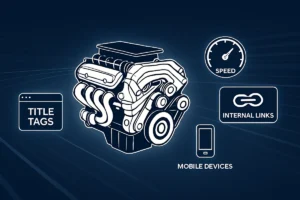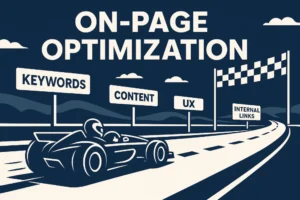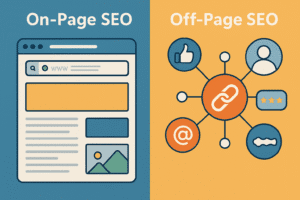Introduction: Why Your Need E-commerce Website Optimization
Why Your Need E-commerce Website Optimization? Well, simply because your e-commerce website is like your online shop. It’s where you show off your products, attract new customers, and make money. To be successful online, your website needs to be easy for customers to use and buy from. This guide is packed with the best tips to make your online store a success, keeping in mind the ever-evolving landscape of retail as detailed in The Ultimate Guide to the Retail Industry 2024: Shifting Paradigms.
Understanding Consumer Behavior: Key to E-commerce Website Optimization
What Makes Online Shoppers Tick?
Before you start changing your website, take some time to understand how people shop online. What do they like to see? What makes them frustrated? By learning about their habits, you can design your website to make them happy and more likely to buy. To stay ahead of the curve, it’s crucial to stay informed about the latest E-commerce Growth Trends: All You Need to Know to Thrive in 2025.
Consider these questions:
- What kind of products do they usually buy online?
- How do they find products they’re interested in?
- What makes them decide to buy or not buy?
Too Many Choices Can Confuse: Keep It Simple
Imagine walking into a store with too much stuff everywhere. It’s overwhelming! The same goes for online shopping. Research shows that too many choices confuse customers. Simplify your product categories and only display the best options. This makes it easier for customers to decide, leading to more sales.
Think of it like this: Would you rather choose from five different shirts or fifty? Most people prefer fewer choices because it’s easier to decide.
The Power of Social Proof: Show What Others Think
People trust the opinions of others. That’s why reviews and ratings are so important. Show off positive feedback from other customers on your product pages. This builds trust and encourages more people to buy from you.
Imagine you’re trying to decide between two different products. One has hundreds of positive reviews, and the other has none. Which one are you more likely to buy?
E-commerce Website Optimization Tips for Design and User Experience
Your website’s design is like your store’s decorations. A well-designed website makes customers feel welcome and excited to shop. Follow these tips to make your website look its best:
Mobile-First Design: Think Small Screens
Most people shop on their phones, so your website must work perfectly on small screens. Everything from buttons to text should be easy to see and tap. A mobile-friendly website means more happy customers and more sales.
Imagine trying to read tiny text on your phone or clicking on a button that’s too small. It’s frustrating, right? That’s why mobile-first design is so important. Google says so too – here in this article.
Easy Navigation: Guide Your Customers
Make your website easy to navigate so customers can find what they’re looking for quickly. Use clear menus, categories, and a big search bar. Think of it like a map that helps customers find their way around your store.
Imagine going to a store where the aisles are a mess and you can’t find anything. You’d probably leave, right? The same goes for websites. Clear navigation is key to keeping customers happy.
Speed Matters: Don’t Keep Customers Waiting
People are busy and impatient. If your website takes too long to load, they’ll leave without buying anything. Use smaller images and avoid too many extra features that slow your site down.
Imagine waiting in a long line at the store. It’s annoying, right? That’s how customers feel when websites are slow. Speed up your website to keep customers happy.
Perfect Your Product Pages: E-commerce Website Optimization Tips for Product Pages
Tell a Story with Product Descriptions
Your product descriptions are more than just lists of features. They’re your chance to tell a story about your product. Use exciting words to explain how your product can solve a problem or make someone’s life better. Also, use words that people might type into search engines to find your product. This will help them find you!
Imagine you’re reading a story about a magical product that solves all your problems. Doesn’t that make you want to buy it? That’s the power of good product descriptions.
High-Quality Images and Videos: An E-commerce Website Optimization Must Have
A Picture is worth a thousand wrds. Pictures and videos help customers imagine owning your product. Use clear, high-quality images from different angles. Videos can help even more! Show your product in action and highlight its unique features.
Imagine seeing a delicious-looking cake in a picture. Doesn’t it make you want to eat it? High-quality images and videos can have the same effect on your customers.
Clear Calls to Action: Guide Customers to Buy
Tell customers what to do next with big, bright buttons like “Add to Cart” or “Buy Now.” Use strong words that encourage them to click and buy your product.
Imagine a sign in a store that says “Buy now and get 50% off!” That’s a call to action. It tells you what to do and gives you a reason to do it.
E-commerce Website Optimization Tips for SEO and Marketing: Get Found Online
Your website needs visitors to make sales. These tips will help you bring more people to your online store:
Keyword Research: Speak Your Customers’ Language
Imagine you’re trying to find a new pair of shoes online. What words would you type into the search bar? Those are keywords. Figure out what words and phrases your customers use to search for products like yours. Use these keywords in your product descriptions, titles, and other content on your website.
This helps search engines like Google understand what your website is about and show it to the right people. It’s like putting up a sign that says “We sell shoes!” so people looking for shoes can find you easily.
Local SEO: Be the Local Hero
If you have a physical store or sell to local customers, include your business name, address, and phone number on your website. This helps people near you find you on search engines when they’re looking for products or services you offer.
Imagine you’re hungry and looking for a pizza place nearby. You’d probably search online for “pizza near me.” If your pizza place has its address and phone number online, it’s more likely to show up in those search results.
Social Media Marketing: Get Social
Social media platforms like Facebook, Instagram, and Twitter are great places to promote your products and connect with potential customers. Share interesting posts, run contests, and interact with your followers to build relationships and attract new customers.
Imagine you see a cool new product on your friend’s Instagram. You might click on their link and check it out. That’s the power of social media marketing.
Smooth Sailing Checkout: Easy Buying Process
Guest Checkout: Let Shoppers Skip the Sign-Up
Many customers don’t want to create an account just to buy something. Let them checkout as guests. This makes the process faster and easier, which can lead to more sales.
Imagine going to the grocery store and having to fill out a long form before you can buy anything. You’d probably leave, right? Guest checkout makes it easy for customers to buy without any hassle.
Multiple Payment Options: More Ways to Pay
Different customers prefer different payment methods. Some like credit cards, others prefer digital wallets like PayPal. Offer a variety of payment options to make it convenient for everyone.
Imagine going to a store that only accepts cash. You might not have enough cash on you or prefer to use a card. Offering multiple payment options ensures that you don’t lose out on sales.
Show Security Badges: Build Trust
Customers want to know that their personal and financial information is safe. Display security badges from trusted companies like Norton or McAfee to show that you take security seriously.
Imagine buying something online and seeing a security badge from a company you trust. It makes you feel more confident about making the purchase, right?
Data is Your Friend: Leveraging Data for Continuous E-commerce Website Optimization
Website Analytics: Your Behind-the-Scenes Look
Track, Learn, and Improve. Think of website analytics like a detective’s magnifying glass. It helps you see what’s happening on your website. Tools like Google Analytics show you:
- How people find your website: Do they come from search engines, social media, or other websites?
- What pages they visit most: Which products or pages are the most popular?
- How long they stay on your site: Are customers engaged with your content?
- Where they leave: Are there pages where lots of customers leave without buying?
This information helps you understand what’s working well and what needs improvement. It’s like having a secret map that shows you where the treasure (sales) is hidden!
A/B Testing: Find What Works Best
A/B testing is like a science experiment for your website. You create two versions of a page and see which one performs better. For example, you could test two different headlines to see which one gets more clicks. Or, you could test two different product images to see which one leads to more sales.
By testing different elements of your website, you can find the winning combinations that lead to more conversions. It’s like trying different recipes to find the perfect one!
Listen to Your Customers: Ask for Feedback
The best way to know what your customers want is to ask them directly. You can use surveys, polls, or feedback forms to get their opinions. Ask them what they like and dislike about your website, what products they’re looking for, and what would make their shopping experience better.
Think of it like asking your friends for advice. Their feedback can help you make your website even better.
Partnering with a Web Development Agency: Get Expert Help
Sometimes, you need a little help from the experts. A web development agency can help you with everything from designing your website to optimizing it for search engines.
Benefits of Hiring a Web Development Agency
- Expertise: Web development agencies have the knowledge and experience to create high-quality websites that are optimized for conversions.
- Time-saving: Building and optimizing a website takes time and effort. An agency can take care of everything for you, freeing up your time to focus on running your business.
- Custom solutions: Agencies can create custom solutions tailored to your specific needs and goals.
- Ongoing support: Many agencies offer ongoing support and maintenance to ensure your website stays up-to-date and performs well.
Choosing the Right Agency: Find Your Perfect Match
Not all web development agencies are created equal. It’s important to choose an agency that understands your business and your goals. Look for an agency with a proven track record of success in the e-commerce industry.
Ask for references and check out their portfolio to see examples of their work. Make sure the agency you choose is a good fit for your budget and timeline.
Conclusion: Implementing E-commerce Website Optimization Tips for Success
Optimizing your e-commerce website is an ongoing journey, not a one-time task. By implementing the tips we’ve discussed, you can create a user-friendly, high-performing online store that attracts, engages, and converts visitors into loyal customers.
Remember, the key to success is to always keep your customers in mind. Happy customers are loyal customers, and loyal customers mean more sales for you!
Key Takeaways: Your E-commerce Website Optimization Checklist
Let’s recap the essential e-commerce website optimization tips we’ve covered:
- Understand Your Customers: Learn how they shop online and cater to their needs.
- Simplify Choices: Don’t overwhelm customers with too many options.
- Show Social Proof: Display customer reviews and ratings to build trust.
- Design a Mobile-Friendly Website: Make sure your website looks and works great on mobile devices.
- Simplify Navigation: Make it easy for customers to find what they need.
- Speed Up Your Website: Don’t make customers wait for slow-loading pages.
- Craft Compelling Product Descriptions: Use persuasive language and relevant keywords.
- Use High-Quality Images and Videos: Show off your products in the best light.
- Clear Calls to Action: Guide customers towards making a purchase.
- Keyword Research: Find the words and phrases your customers use to search for products like yours.
- Local SEO: Optimize your website for local search if you have a physical store or cater to a local audience.
- Social Media Marketing: Use social media platforms to promote your products and engage with potential customers.
- Guest Checkout: Allow customers to checkout without creating an account.
- Multiple Payment Options: Offer a variety of payment methods to suit different customer preferences.
- Show Security Badges: Display security badges to build trust and assure customers that their information is safe.
- Track Website Analytics: Use tools like Google Analytics to understand your website’s performance.
- A/B Testing: Test different versions of your website to find what works best.
- Gather Customer Feedback: Ask your customers for feedback to improve their shopping experience.
By implementing these tips and continually learning and improving, you can achieve e-commerce success and watch your online store thrive. Remember, optimization is an ongoing process. Stay up-to-date on the latest trends and best practices to stay ahead of the competition.

I design high-performing WordPress + Elementor websites and WooCommerce stores that rank on Google and convert visitors into customers. At Katmantra Web Design and SEO, I combine clean design with smart SEO so your site works as hard as you do.







